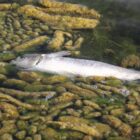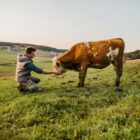From time to time in food systems and farmed animal advocacy, a new issue arises that requires funders and NGOs to make a difficult choice. Will we stand in support or in opposition? Based on the evidence we have, will a new policy, product, industry, or problem framing truly contribute to the kinder, greener, more equitable food future we hope to bring about? Making these thorny decisions involves deep and self-reflective thought. Often there are more unknowns than knowns, and we must make decisions based on probabilities and our incomplete understanding of many intersecting social and environmental issues within the food system. The stances we choose on such divisive issues can shape the relationships we build with other advocates and affect the efficacy of our work.
In this post, Stray Dog Institute aims to make visible the array of challenging questions and overlapping concerns posed by one such complex issue: the recent rise in farming of insects as an alternative protein source. Weighing the pros and cons of insect farming presents a challenge for those working to change the US and global food systems, especially those concerned about the current state of industrial animal agriculture.
Food system advocates approach food systems change from a range of different perspectives, reflecting overlapping but not identical sets of values. Priorities include protecting animal rights, expanding food access for disadvantaged communities, and reducing the negative environmental impacts of food production. Although these priorities are connected, what emerges as a solution worthy of support in one context may do little to address other vital angles of food systems change. Whichever set of values we each hold paramount, organizations and individuals deciding whether to support or oppose insect farming face ethical dilemmas, knowledge gaps, and uncomfortable tradeoffs.
This post will explore a range of questions underlying the new practice of insect farming. Ultimately, each advocate or organization may come to a different conclusion on this issue based on their values and motivations. This post aims not to simplify complexity or suggest uniformity but to encourage thoughtful decisions that consider multiple perspectives.
Insect Protein: Past and Present
In communities worldwide, insects and other arthropods such as spiders have been eaten for centuries as traditional protein sources, a practice known as entomophagy. In high-income industrialized nations, entomophagy has been comparatively less common, with many consumers conditioned to see insects and other arthropods as pests or as wildlife rather than as a food source.
Despite the unequal appeal of entomophagy, insects and other arthropods are increasingly being farmed for their protein by feed producers and food startups across the United States, Europe, and Asia.[1] There is a growing market for this insect protein for direct human consumption, as food for companion animals, and as feed for industrial livestock.
Leaders in the space, such as Dutch firm Protix and French startup Ynsect are gaining impressive venture capital support and positioning themselves as purveyors of a new, more sustainable kind of protein. Marketing slogans promise food that is “in balance with nature” and an “organic, long-term sustainable solution” for protein sourcing. Insect-based food products and restaurants have emerged with marketing that links health and environmental messaging with solutions for global hunger. But is insect farming truly capable of delivering an improved food system for all? What complexities and value judgments are involved in advocating for or against the rise of insect protein?
Underlying the altered future food landscape that insect protein entrepreneurs envision are deep economic, environmental, and ethical questions, many with unclear answers. The questions presented here are intended to be illustrative rather than exhaustive and to suggest a common good framework for assessing the desirability of further expansion of insect farming for food and feed.
Environmental Questions Around Insect Farming
Can insect protein offer lower environmental impacts than industrial production of terrestrial livestock, and under what circumstances? What tradeoffs could become apparent?
Depending on the specifics of insect protein production, there is some evidence that insect farming could have comparatively lower environmental impacts on land, water, and air than conventional animal agriculture.[2] However, deep questions persist over whether these ecological benefits could truly be realized in practice or whether intensive farming of insects would instead place increased pressure on natural environments.
One of the strongest environmental arguments in favor of insect protein is the relative efficiency with which insects can convert resources into human-edible nutrition. On this same metric, vertebrate animals traditionally used for food production are famously inefficient. While it is true that animals raised for food can utilize food sources that humans cannot (e.g., grass), industrial animal feed is composed mainly of conventionally produced corn and soybeans. On average, it takes 2.8kg of human-edible food to create 1kg of meat from ruminants such as cows, sheep, and goats, and 3.2kg of human-edible food for 1kg of meat from monogastric animals like chickens and pigs.[3] The low feed conversion ratio of these animals means that we sink far more resources into their production than we get back in the form of human nourishment.
Insects, on the other hand, can be more than an order of magnitude more resource-efficient. Crickets, for example, are twice as efficient feed converters compared to chickens, four times as efficient compared to pigs, and twelve times as efficient as beef cows.[4] Additionally, insects reproduce in far higher numbers, do not require large areas of land, and grow to maturity in a fraction of the time that it takes terrestrial vertebrate animals to be raised for meat—all features that contribute to insect farming’s appeal in multilateral food security discussions.
Insects can convert protein efficiently under certain circumstances, but the broader environmental impacts of insect farming are unclear.
Why does resource efficiency matter in environmental terms? Meat production currently creates an incredible amount of planetary damage. Roughly 70 billion animals are raised and slaughtered each year to feed humans around the world. Feeding these animals with their higher feed conversion ratios uses the output of 75-80% of all agricultural lands.[5],[6] This includes consuming one-third of global grain output[7] and one-quarter of global freshwater resources,[8] and producing a majority of the food system’s significant contribution to global greenhouse gas emissions.[9]
If including insects in our diets could lessen the environmental pressures of animal production, especially by reducing the risk of catastrophic climate change, there could be a strong ecological reason to support insect farming. However, some analyses have cast doubt on the low resource use of insects when produced at scale in industrial systems. Resource needs such as the high temperatures required during insect growth cycles complicate the resource use equation, making insect production more resource-intensive than feed conversion ratios alone would suggest.[10]
Ultimately, an environmental analysis of insect farming must consider the exact character of insect farming and the end-use of insect protein. A blanket environmental endorsement is impossible to make without first establishing linkages to the larger food system. Will insect protein in human and companion animal diets substitute for vertebrate protein sources, or will it become an additional food source and another supporting pillar of existing industrial animal agriculture? These and other economic and systemic questions must also play a role in any environmentally motivated decision to support or oppose the expansion of insect-derived protein.
Economic and Systemic Questions Around Insect Farming
If insect production could take the place of some or most existing animal production, lower resource use by insects compared to vertebrate animals could theoretically yield lower environmental impacts. Exactly how likely and how feasible is such a substitution? How might the economics of food production in a food system dominated by multinational agribusiness help or hinder the realization of environmental benefits?
Insect farming is likely to contribute to—and even expand—industrial animal farming.
Recent analysis suggests that the massive increase of chicken and fish consumption globally—and especially among nations of the Global North—between 1961 and 2013 has not displaced consumption of other meats but has instead added to overall meat consumption.[11] Could the same happen with insect protein? Even the lower potential resource use of insects as a human food source will deliver no actual environmental benefit if insect consumption becomes additional to current meat consumption.
Worse, insect farming is likely to play a significant role in continuing—and even expanding—industrial animal farming. Several of the leading insect producers simultaneously market insect protein as both an ingredient for processed foods and a replacement for the fishmeal in industrial livestock feed. Insect farming could be poised to produce a rapidly increasing portion of the protein in animal feed, further entrenching livestock production and its array of environmental impacts. So, while human consumption of insect protein might come with lower environmental costs for the planet than consuming conventional meat, supporting the commercial insect industry may have the opposite effect.
Where insects can be reared from crop and animal waste streams that otherwise have no outlet, there are compelling arguments on both sides of the environmental debate, mediated by systemic factors. Deriving usable resources from animal waste such as manure seems like a clear economic and environmental win by creating a food source from a waste stream. Insects such as black soldier flies can also neutralize harmful bacteria like E. coli[12] while reducing the volume of organic waste streams that put pollution pressure on waterways. However, even this waste-to-food win-win becomes a mirage when one considers that the majority of farmed insects today consume usable grain or high quality foodstuffs that would otherwise go to farmed animals, rather than dining on food waste or animal waste.
Even if waste were used as feed, the engine of industrial animal farming is constantly seeking ways to lower costs and raise output from animal exploitation. Producing insects as animal feed using animal waste streams further increases the cost efficiency of intensive livestock production, which could lead to increases in numbers of animals raised, swamping any potential environmental benefit. Improving the cost efficiency of industrial meat is the last thing that most farmed animal and food systems advocates want, and it is the most likely result of increased insect protein production.
Farming insects for animal feed maintains the dominance of a deeply unequal and exploitative industrial food system permeated by systemic racism and human and animal rights abuses while strengthening the wealth flows that concentrate profits into the hands of large corporate brands. Because it fits so well within the existing industrial production system, insect protein is unlikely to drive necessary change for food system workers and low-income communities facing chronic food insecurity, nor is it likely, on its own, to catalyze deeper systemic transformation.
Ethical Questions Around Insect Farming
Ethical considerations are among the thorniest of questions in evaluating the positives and negatives of insect farming. The ethics of eating insects are especially complicated for those opposing conventional industrial animal farming on ethical grounds. Is it ethically justifiable to consume insects in place of consuming other animals? Is it morally permissible—or even morally imperative—to transition from vertebrate animal farming to insect farming if doing so can spare the lives of definitely sentient livestock animals, help avert climate collapse, and contribute to eradicating global hunger?
A fundamental question at the root of ethical arguments for or against insect farming is the question of invertebrate sentience. If invertebrates such as flies, beetles, larvae, and spiders are creatures with awareness and emotional depth, then many environmental and nutritional arguments for their consumption gain a dark and unsettling moral weight.
Roughly 1 trillion insects harvested for food each year means a staggering degree of avoidable suffering, in addition to the suffering of farmed vertebrate animals that farmed insect protein will support.
The large number of insects that can be raised on a smaller resource base and their rapid reproduction in farmed conditions potentially exponentially inflates the number of beings impacted by exploitation, suffering, and slaughter. Estimates place the number of insects harvested yearly for human and animal consumption at between 1 and 1.2 trillion, compared to 70 billion vertebrate animals killed each year in the food system. Moreover, the insect industry is growing rapidly. If sentient, these invertebrates and their exploitation in the name of nutrition could amount to a staggering degree of avoidable suffering.
However, little is known definitively about the sentience of invertebrates. Estimating the probability of invertebrate sentience in the absence of sufficient data is a topic that divides even ethics pioneers and sentience researchers committed to improving humanity’s moral decision-making regarding other animals. Research suggests that there is substantial evidence that invertebrates possess at least some elements of consciousness. Other indicators seem notably absent, or understudied and inconclusive. Data are scarce, and evidence for sentience varies from one species to another, making it difficult to generalize.
Some have suggested employing the precautionary principle in invertebrate ethics by assuming insect sentience unless research can prove the opposite.[13] Applying precautionary ethics to the species on which the insect protein industry is built leads to a stark proposition: Could it ever be ethical to exploit trillions of beings (invertebrates) in an attempt to free a lesser number of other beings (vertebrates) from exploitation?
Even if invertebrate sentience could be ruled out, the production of insect protein as an animal feed source poses its own ethical dilemmas. Thus far, the production of certain insects such as black soldier fly larvae has mainly replaced fishmeal in farmed animal feed. The effect of this substitution is to continue the intensive animal agriculture model as designed, thereby increasing the exploitation of more likely sentient creatures like chickens, pigs, and cows. What’s more, insect exploitation within the existing industrial food system will do nothing to lessen the impacts of conventional animal agriculture on people, local ecosystems, or farmed animals.
Conclusion
Assessing the positive and negative potential of any innovation in the food system raises inherent questions around the values we ascribe to elements of food production and our relative priorities when faced with tradeoffs between environmental sustainability and animal welfare or between human utility and ethical action. Whatever values guide each of us, the growth of the insect farming industry makes it imperative that food system advocates and funders explore its environmental, economic, and ethical implications.
The US food system needs solutions for multiple profound structural challenges, including a history of racism and human rights abuses in food production, widespread exploitation of animals, rising corporate control and consolidation within food production, and unequal access to healthy food. These problems exist alongside the destabilizing threat of global climate change and the increasing demand for meat and other animal products.
At Stray Dog Institute, we choose to consider these interconnected problems through the lens of systems thinking. We reserve our support for innovations that have the potential to bring transformation by simultaneously addressing multiple issues and preventing further entrenchment of industrial animal agriculture. We encourage advocates to further explore the potential impacts of insect farming, evaluating its environmental and ethical claims in the context of food systems transformation. We hope that the farmed animal movement will hold insect farming and other proposed innovations for protein production to a high standard of social and environmental benefit. In the search for a better food system, we cannot afford to pursue quick fixes instead of deeper, more difficult transformative opportunities, nor can we afford to fix one problem while worsening another.
[1] Wilkie, Rhoda M. “‘Minilivestock’ Farming: Who Is Farming Edible Insects in Europe and North America?” Journal of Sociology 54, no. 4 (2018): 520–37, https://doi.org/10.1177/1440783318815304.
[2] Huis, Arnold van, and Dennis G. A. B. Oonincx. “The Environmental Sustainability of Insects as Food and Feed. A Review.” Agronomy for Sustainable Development 37, no. 5 (September 15, 2017): 43. https://doi.org/10.1007/s13593-017-0452-8.
[3] Anne Mottet et al., “Livestock: On Our Plates or Eating at Our Table? A New Analysis of the Feed/Food Debate,” Global Food Security, Special Issue: Food Security Governance in Latin America, 14 (September 1, 2017): 1–8, https://doi.org/10.1016/j.gfs.2017.01.001.
[4] Baiano, Antonietta. “Edible Insects: An Overview on Nutritional Characteristics, Safety, Farming, Production Technologies, Regulatory Framework, and Socio-Economic and Ethical Implications.” Trends in Food Science & Technology 100 (2020): 35–50, https://doi.org/10.1016/j.tifs.2020.03.040.
[5] J.A. Foley et al., “Solutions for a Cultivated Planet,” Nature 478, no. 7369 (October 20, 2011): 337–42, https://doi.org/10.1038/nature10452.
[6] Susanne Stoll-Kleemann and Tim O’Riordan, “The Sustainability Challenges of Our Meat and Dairy Diets,” Environment: Science and Policy for Sustainable Development 57, no. 3 (May 4, 2015): 34–48, https://doi.org/10.1080/00139157.2015.1025644.
[7] See endnote 3.
[8] Arjen Ysbert Hoekstra, “The Hidden Water Resource Use behind Meat and Dairy,” Animal Frontiers 2, no. 2 (2012): 3–8, https://doi.org/10.2527/af.2012-0038.
[9] P.J. Gerber et al., “Tackling Climate Change through Livestock: A Global Assessment of Emissions and Mitigation Opportunities” (Rome: Food and Agriculture Organization of the United Nations, 2013), http://www.fao.org/3/i3437e/i3437e.pdf.
[10] Anthis, Jacy Reese, and Eze Paez. “Moral Circle Expansion: A Promising Strategy to Impact the Far Future.” Futures 130 (June 1, 2021): 102756. https://doi.org/10.1016/j.futures.2021.102756.
[11] York, Richard. “Poultry and Fish and Aquatic Invertebrates Have Not Displaced Other Meat Sources.” Nature Sustainability, April 26, 2021. https://doi.org/10.1038/s41893-021-00714-6.
[12] Huis, Arnold van, and Dennis G. A. B. Oonincx. “The Environmental Sustainability of Insects as Food and Feed. A Review.” Agronomy for Sustainable Development 37, no. 5 (September 15, 2017): 43. https://doi.org/10.1007/s13593-017-0452-8.
[13] Baracchi, David, and Luigi Baciadonna. “Insect Sentience and the Rise of a New Inclusive Ethics.” Animal Sentience 5, no. 29 (January 1, 2020). https://doi.org/10.51291/2377-7478.1604.




